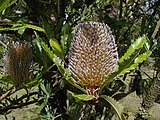Banksia aemula, commonly known as the wallum banksia, is a shrub of the family Proteaceae. Found from Bundaberg south to Sydney on the Australian east coast, it is encountered as a shrub or a tree up to 8 m (26 ft) tall in coastal heath on deep sandy soil known as Wallum. It has wrinkled orange bark and shiny green serrated leaves, with green-yellow flower spikes, called inflorescences, appearing in autumn. The flower spikes turn grey as they age and large grey follicles appear. B. aemula resprouts from its woody lignotuber after bushfires. Aemula, Latin for "similar", comes from its resemblance to the closely related Banksia serrata. First described by the botanist Robert Brown in the early 19th century, it was known for many years in New South Wales as Banksia serratifolia. This name, originally coined by Richard Anthony Salisbury, proved invalid, and since 1981 Banksia aemula has been accepted as the scientific name. A wide array of mammals, invertebrates, and birds, particularly honeyeaters, visit the inflorescences and are instrumental in pollination. It is grown as a garden plant, but less commonly than B. serrata. (Full article...)
- Recently featured:
from Wikipedia featured articles feed http://ift.tt/20OHdnM







0 commentaires:
Enregistrer un commentaire